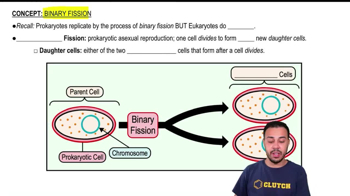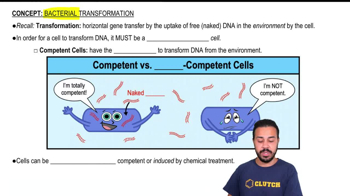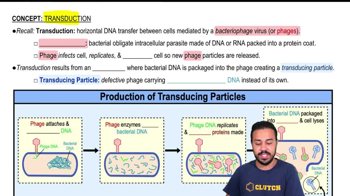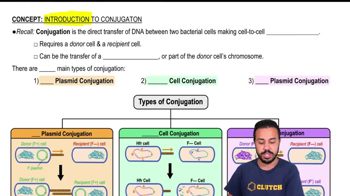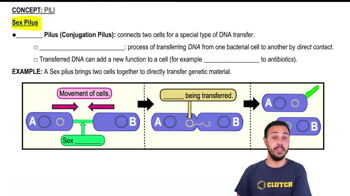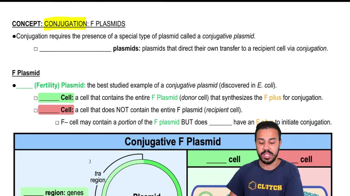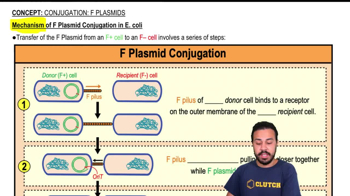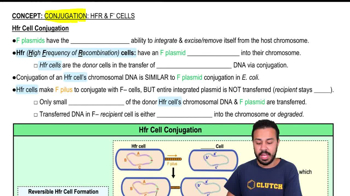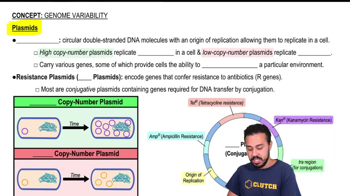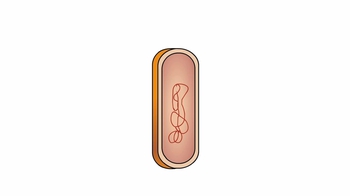So the last way that prokaryotes can introduce genetic variation is through what's known as conjugation. And this is, unlike the other methods we discussed, a direct transfer of genetic material between two physically linked bacterial cells. And this is going to involve that appendage we previously discussed called a pilus. The plural of that, in case you're curious, is pili; that's the plural form of pilus. You know, Latin words are going to have strange forms to them. Anyway, this is an appendage used to connect the two cells that are going to be involved in conjugation and really, what this all boils down to is the presence of this special plasmid called the F plasmid. And, this plasmid can actually become incorporated into the chromosome, the actual chromosomal DNA of a cell. So really, it's probably better to just call it the F factor. Right? That term F factor can both mean the F plasmid and also, the F plasmid genes, having been incorporated into the chromosomal DNA. So essentially, these are just a bunch of genes required for this genetic transfer. In order to have conjugation, you need what is called an F-positive bacteria, F⁺. And basically, this is just a bacteria that possesses the F plasmid. You can also have this F-prime bacteria. You see that little symbol right there, that's prime. And these are bacteria that have the F factor incorporated into their bacterial chromosome. Right? So you need either F⁺ or F prime, and you also need an F-minus bacteria or a bacteria that is lacking the F factor and is going to act as a recipient of the genes. Right? So, the bacteria that has the F factor is going to pass on the genes, and bacteria that lacks it is going to receive them. So looking at our little model here, basically, you have what's called the donor and it is going to extend its pilus and guess what? The genes for that pilus are part of the F plasmid. Go figure, right? So it's going to connect to the recipient cell and from there, the two are going to be linked. The pilus is actually going to kind of pull them together. There's going to be an opening between the cells and the genetic information is going to be transferred, you can see from the donor cell into the recipient cell there. And at that point, that cell that receives the F plasmid is going to become a cell that is now capable of acting as a donor. And, let me hop out of the picture so you can see that. Yeah. So, it is now going to be an F⁺ cell. Right? This one was F⁺ the whole time, This is newly F⁺. So it's F⁺ old, F⁺ new. Whatever you want to call it. Old donor, new donor. Right? So now, this new donor, now it can make its own pilus. Right? Because now it has the genes too. So, this is a very simplified version of what goes on during conjugation. And again, the main idea is that it involves direct gene transfer from a cell that contains the F factor to a cell that does not contain the F factor. Now, there is a special case of conjugation that involves what's called an R plasmid. And this is a plasmid that carries a gene that will confer antibiotic resistance. So, that's why I say I shouldn't say just. These are actually super important. Antibiotic resistance is probably the most important topic in microbiology right now because there are many species that are becoming resistant to most forms, if not all forms, of the antibiotics that humans have developed. So, an R plasmid is a plasmid that carries the gene that confers some type of antibiotic resistance. It's worth noting that not only can these be transferred via conjugation, but our R plasmids can also be transmitted by transformation and transduction. Alright. That's all I have for this video. See you guys next time.
Table of contents
- 1. Introduction to Biology2h 40m
- 2. Chemistry3h 40m
- 3. Water1h 26m
- 4. Biomolecules2h 23m
- 5. Cell Components2h 26m
- 6. The Membrane2h 31m
- 7. Energy and Metabolism2h 0m
- 8. Respiration2h 40m
- 9. Photosynthesis2h 49m
- 10. Cell Signaling59m
- 11. Cell Division2h 47m
- 12. Meiosis2h 0m
- 13. Mendelian Genetics4h 41m
- Introduction to Mendel's Experiments7m
- Genotype vs. Phenotype17m
- Punnett Squares13m
- Mendel's Experiments26m
- Mendel's Laws18m
- Monohybrid Crosses16m
- Test Crosses14m
- Dihybrid Crosses20m
- Punnett Square Probability26m
- Incomplete Dominance vs. Codominance20m
- Epistasis7m
- Non-Mendelian Genetics12m
- Pedigrees6m
- Autosomal Inheritance21m
- Sex-Linked Inheritance43m
- X-Inactivation9m
- 14. DNA Synthesis2h 27m
- 15. Gene Expression3h 20m
- 16. Regulation of Expression3h 31m
- Introduction to Regulation of Gene Expression13m
- Prokaryotic Gene Regulation via Operons27m
- The Lac Operon21m
- Glucose's Impact on Lac Operon25m
- The Trp Operon20m
- Review of the Lac Operon & Trp Operon11m
- Introduction to Eukaryotic Gene Regulation9m
- Eukaryotic Chromatin Modifications16m
- Eukaryotic Transcriptional Control22m
- Eukaryotic Post-Transcriptional Regulation28m
- Eukaryotic Post-Translational Regulation13m
- 17. Viruses37m
- 18. Biotechnology2h 58m
- 19. Genomics17m
- 20. Development1h 5m
- 21. Evolution3h 1m
- 22. Evolution of Populations3h 52m
- 23. Speciation1h 37m
- 24. History of Life on Earth2h 6m
- 25. Phylogeny2h 31m
- 26. Prokaryotes4h 59m
- 27. Protists1h 12m
- 28. Plants1h 22m
- 29. Fungi36m
- 30. Overview of Animals34m
- 31. Invertebrates1h 2m
- 32. Vertebrates50m
- 33. Plant Anatomy1h 3m
- 34. Vascular Plant Transport2m
- 35. Soil37m
- 36. Plant Reproduction47m
- 37. Plant Sensation and Response1h 9m
- 38. Animal Form and Function1h 19m
- 39. Digestive System10m
- 40. Circulatory System1h 57m
- 41. Immune System1h 12m
- 42. Osmoregulation and Excretion50m
- 43. Endocrine System4m
- 44. Animal Reproduction2m
- 45. Nervous System55m
- 46. Sensory Systems46m
- 47. Muscle Systems23m
- 48. Ecology3h 11m
- Introduction to Ecology20m
- Biogeography14m
- Earth's Climate Patterns50m
- Introduction to Terrestrial Biomes10m
- Terrestrial Biomes: Near Equator13m
- Terrestrial Biomes: Temperate Regions10m
- Terrestrial Biomes: Northern Regions15m
- Introduction to Aquatic Biomes27m
- Freshwater Aquatic Biomes14m
- Marine Aquatic Biomes13m
- 49. Animal Behavior28m
- 50. Population Ecology3h 41m
- Introduction to Population Ecology28m
- Population Sampling Methods23m
- Life History12m
- Population Demography17m
- Factors Limiting Population Growth14m
- Introduction to Population Growth Models22m
- Linear Population Growth6m
- Exponential Population Growth29m
- Logistic Population Growth32m
- r/K Selection10m
- The Human Population22m
- 51. Community Ecology2h 46m
- Introduction to Community Ecology2m
- Introduction to Community Interactions9m
- Community Interactions: Competition (-/-)38m
- Community Interactions: Exploitation (+/-)23m
- Community Interactions: Mutualism (+/+) & Commensalism (+/0)9m
- Community Structure35m
- Community Dynamics26m
- Geographic Impact on Communities21m
- 52. Ecosystems2h 36m
- 53. Conservation Biology24m
26. Prokaryotes
Prokaryotic Reproduction
Video duration:
5mPlay a video:
Related Videos
Related Practice




